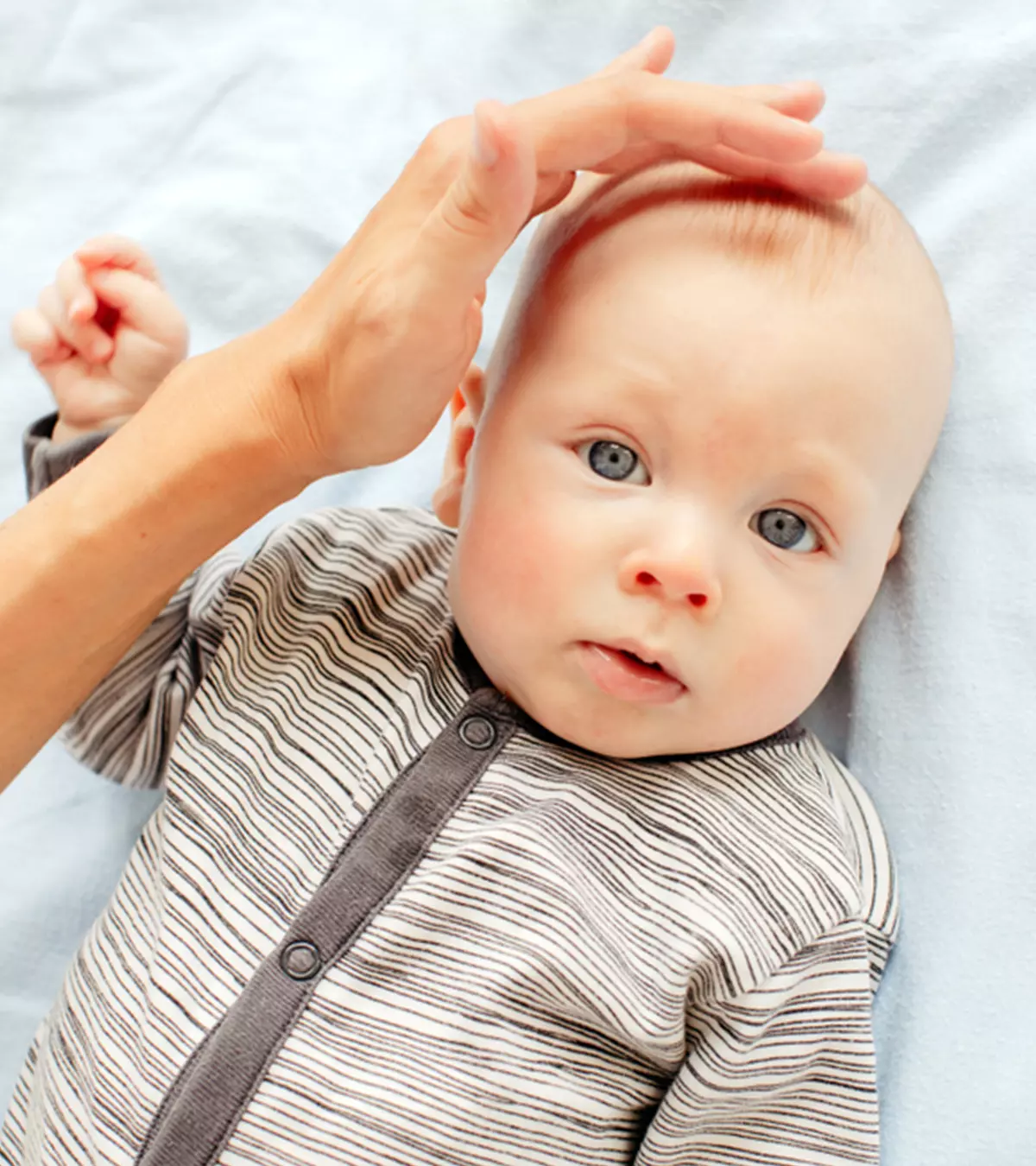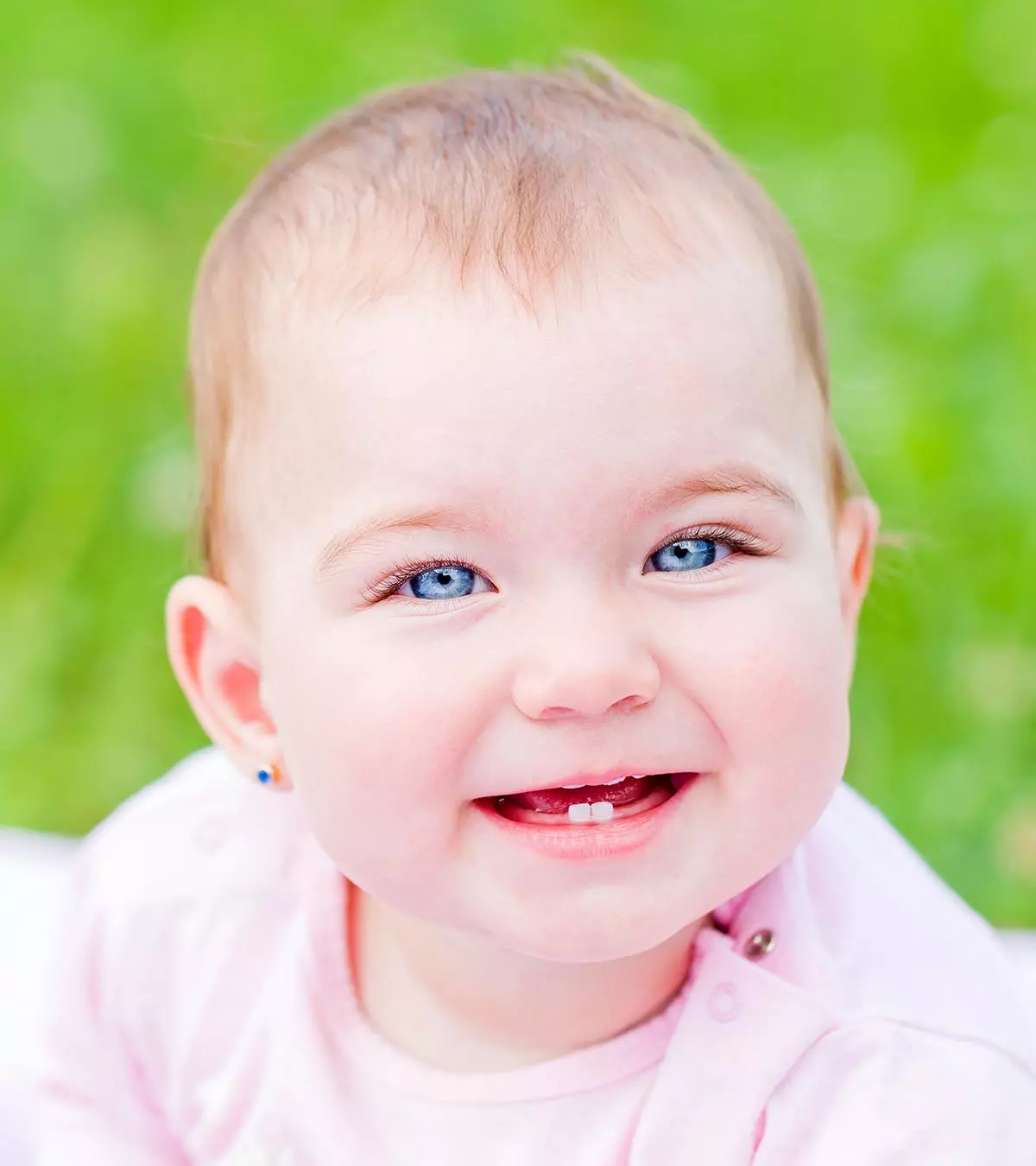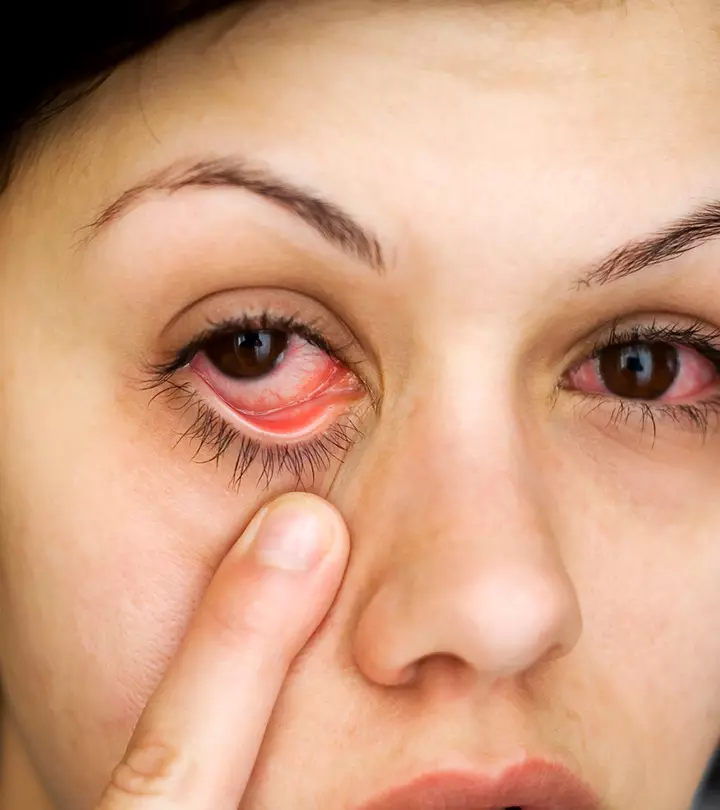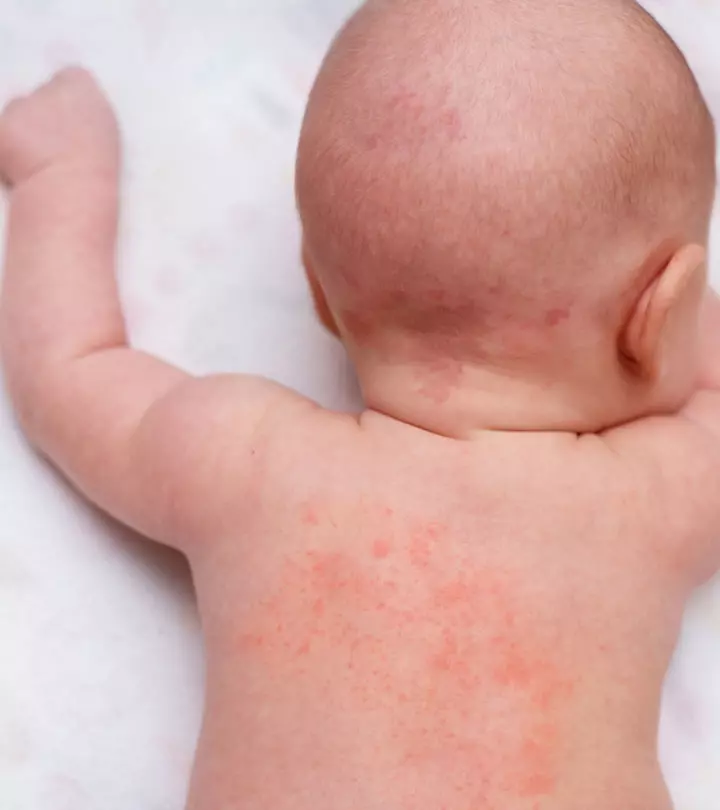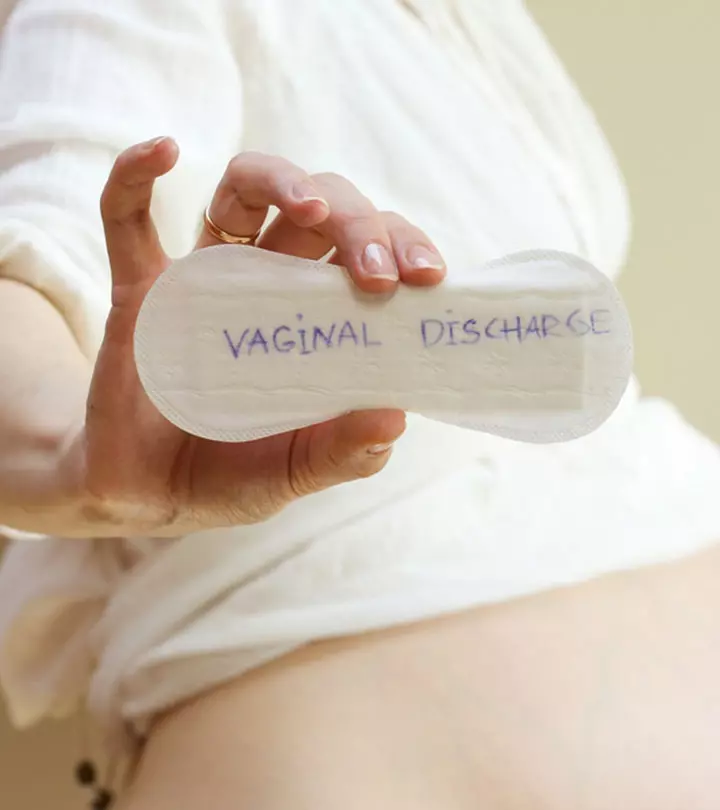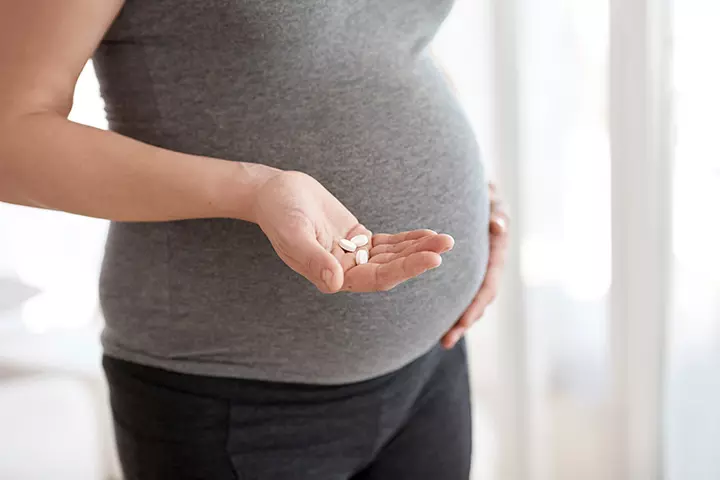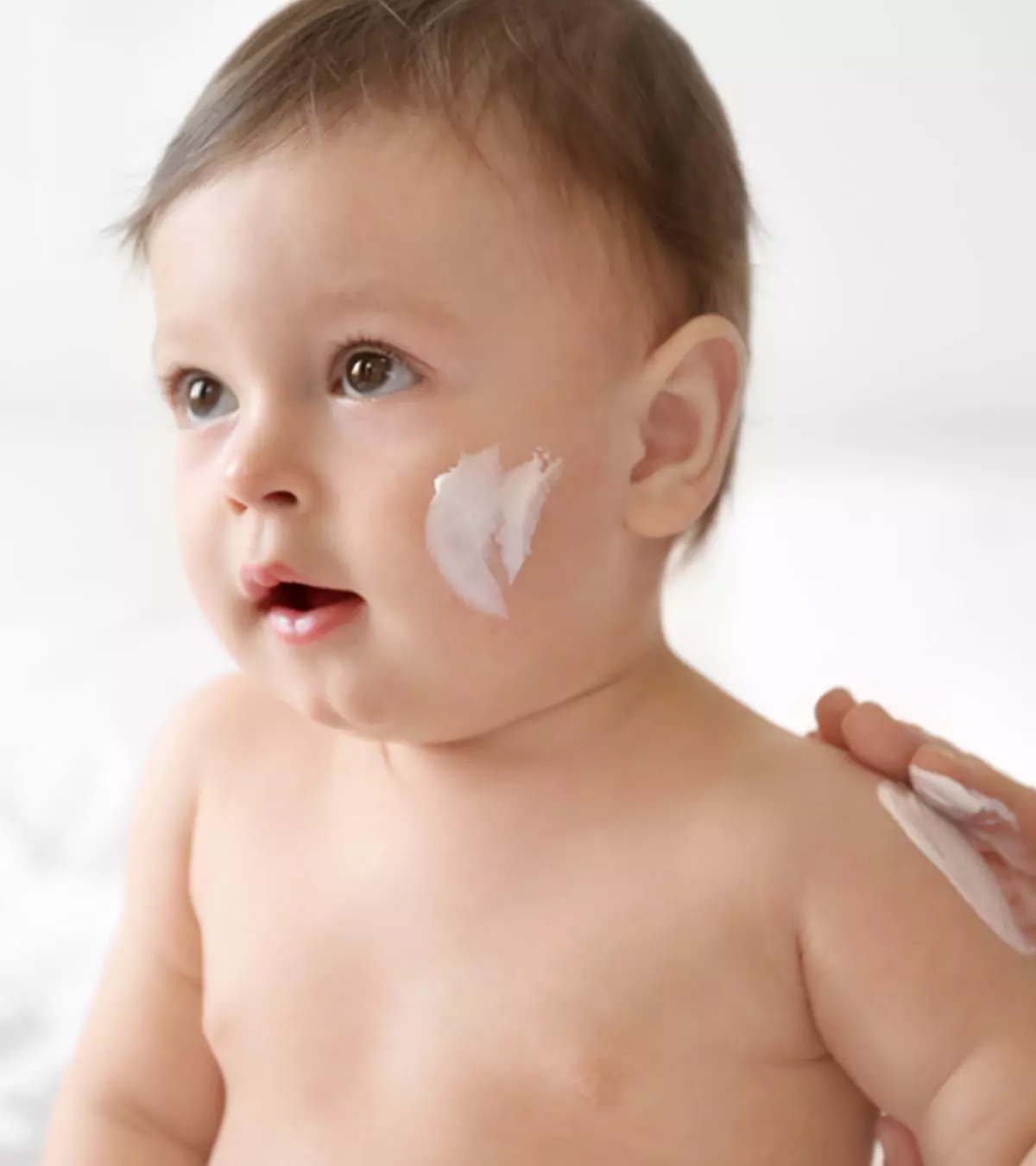
Image: ShutterStock
Fleas may infest babies if they are unmonitored. Flea bites on babies may manifest as mild rashes to severe allergies, depending on their body’s response. As babies cannot clearly express their problems, pay close attention to their responses to stimuli. Observing your baby for any signs of fleabites is essential to help relieve symptoms and related discomforts at the earliest.

Read this post to learn more about what flea bites look like, how to prevent and treat them, and its consequences.
Key Pointers
- Flea bites can cause red bumps or lines, allergic reactions on skin, fever, and itching in babies.
- Fleas could spread bacterial diseases such as typhus and plague.
- Skin scratching can lead to fungal or bacterial infections.
- Calamine lotion, aloe vera gel, OTC ointments, and cold compression can relieve skin irritation and itching due to flea bites.
What Are Fleas?
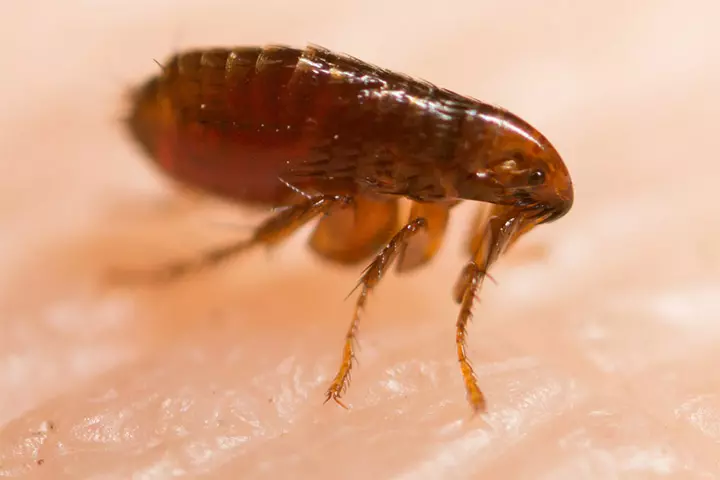
Fleas are tiny parasitic insects that feed on the blood of warm-blooded animals. Usually found dwelling on the fur of animals, tall grasses, rugs, and doormats in the house, they are light brown to black and have a high reproduction rate. These are commonly seen during warm weather (1).
They can leap 50 times their body weight and get firmly attached to the skin to suck blood (2). Fleas can be killed by pesticide treatment of the house and by treating pets with appropriate pet-friendly medications.
What Do Fleabites Look Like?
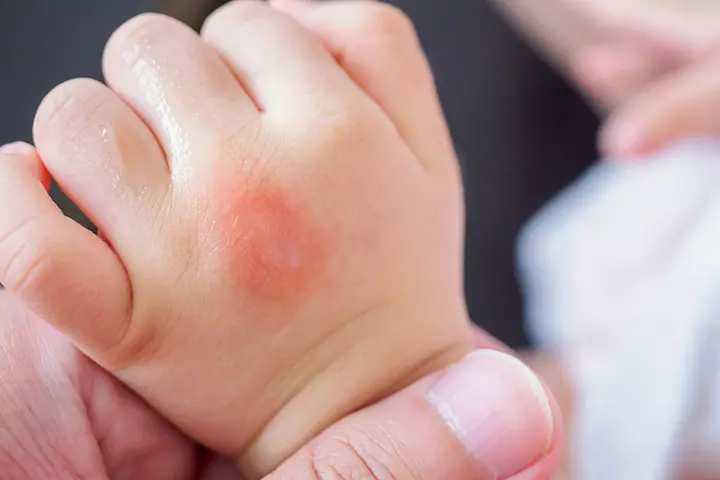
Like mosquitos, ticks, and bedbug bites in babies, flea bites can cause a considerable amount of discomfort. Identifying fleabites is essential to decide the treatment and necessary actions to prevent future contact with insects. To look for flea bites, undress the baby from head to toe and check for the marks on the whole body, including scalp.
Flea bites can cause the following signs and symptoms.
- Inconsolable crying
- Itching
- Fever
- Small bumps with redness
- Clusters of few bumps or lines of redness (3)
- Bumps are sore, painful, and itchy
- Some children may develop blisters, swelling, hives, or rash around the fleabites as an allergic reaction (4)
- The common sites of fleabites are legs, ankles, groins, waist, buttocks, thighs, and lower abdomen (5)
Dr. Rosmy Barrios, a regenerative medicine expert, explains, “When a flea bite gets in contact with some substances, certain reactions begin in the body. One is the active release of histamine, a natural substance that triggers the immune response process. Because of histamine, the flea bites start to redden, swell, and itch.”
Complications Of Flea Infestations In Babies
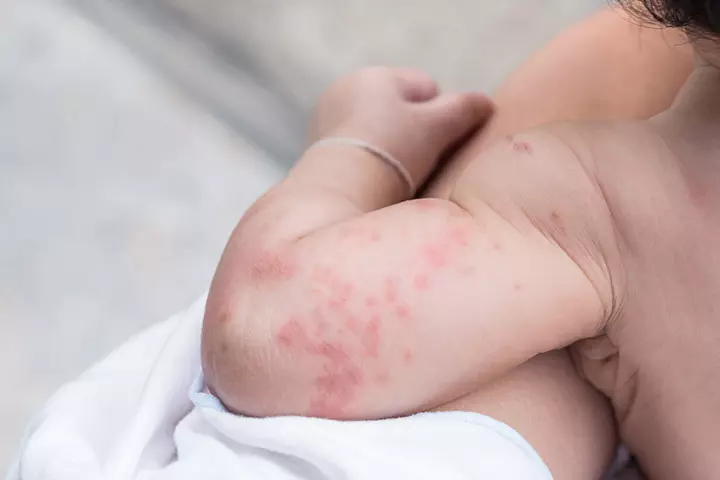
Fleabites and the presence of fleas around the baby may lead to the following consequences and health complications.
- According to the US Centers For Disease Control and Prevention (CDC), fleas could carry bacteria, which could cause diseases, such as typhus and plague, in humans (6).
- Scratching the fleabites may lead to fungal and bacterial infections, causing further complications.
- Skin problems, such as dermatitisiInflammatory skin conditions causing red rashes, dryness, and itchiness and allergic urticarialiSwollen, itchy, and red bumps on the skin surface , have been reported in many cases of flea bites (7).
- Flea-borne typhus fever is a serious illness due to flea bites. It can cause fever, chills, vomiting, nausea, loss of appetite, and rashes in babies, lasting for about a week (8).
- Infected fleas could indirectly spread cat scratch disease, which spreads in humans through cat bites or scratches (9).
- Human cases of plague due to flea bites are rare but, if affected, can be seen as sores and abscessesiA condition marked by swollen, painful, pus-filled bumps, usually caused by bacteria in the glands of the arms and legs.
- Swallowing an infected flea may lead to intestinal tapeworms (10).
- Murine Typhus can also be caused by flea bites (10).
- According to a study, published in the World Allergy Organization Journal, Papular urticariaiAn allergic reaction to insect bites causing painful lumps, sometimes filled with fluid affects children more than adults due to flea bites (11).
- TungiasisiInflammatory skin disease caused by female sand fleas (Tunga penetrans) can be caused due to burrowing fleas (1).
 Quick fact
Quick factTreatment For Fleabites In Babies

Wash the area with water and mild soap to avoid allergic reactions on the skin. Also, use any of these ways to relieve the symptoms of flea bites.
- Calamine lotion: It helps reduce allergic reactions, soothes the skin, and reduces signs of inflammation and itching (18).
- Over-the-counter ointments: Hydrocortisone creams help reduce skin reactions, allergies, and dermatitis (5). Board-certified diplomate of the Philippine Pediatric Society, Dr. Maria Carmela Villania-Mamauag, suggests, “In the case of flea bites in babies, soothing measures are important. Applying calming gels, creams, or lotions, administering oral antihistamines, and maintaining proper hygiene can help reduce discomfort and prevent complications.” Do consult the child’s pediatrician before using any medicated products for the baby.
- Anti-allergic drugs: Doctors may prescribe antihistamine drugs to reduce the symptoms of flea bites (12).
In addition to the above treatments and medications, here are a few generally safe and mild home remedies that may help alleviate discomfort associated with flea bites in babies.
- Nail-trimming: Cut the baby’s nails to avoid scratching and further worsening the condition with secondary bacterial or fungal infections (13).
- Cold compression: Place ice or cold water wipes over the flea bites to help reduce the soreness, redness, and itching (17).
- Aloe vera gel: It works as an anti-inflammatory and antibacterial product (17).
- Essential oils: Tea tree oil, sweet almond oil, rosemary oil, and coconut oils are known to help reduce itching and inflammation.
- Baby lotions: These soothe the skin and reduce itching.
- Oatmeal bath: Add colloidal oatmeal to a lukewarm bath and let the baby soak for a short period. Certain properties of oatmeal are believed to help relieve itching (12).
- Chamomile Tea Compress: Brew chamomile tea, let it cool, and use it as a compress on the bites. Chamomile’s anti-oxidant and anti-histamine properties may be soothing for the skin (14).
- Baking Soda Paste: Mix a small amount of baking soda with water to create a paste. Gently apply the paste to the flea bites and leave it on for about 15 to 20 minutes before rinsing with water (4).
 Quick tip
Quick tipIf the signs of flea bites do not reduce or the baby is having a fever or seems to be dull, consult the doctor for appropriate treatment. If your baby has a severe allergic reaction, like trouble breathing, excessive swelling, or signs of infection such as pus or redness around the bites, get emergency medical help right away.
Prevention Of Flea Bites In Babies
Pediatrician Dr. Raashid Hamid says, “Preventing flea bites starts with maintaining a clean environment—regularly vacuuming, washing bedding, treating pets, dressing babies in lightweight, long-sleeved clothing, and using baby-safe repellents can help prevent flea bites in babies.”
Avoiding any contact with fleas is the best solution for babies. It can be done in the following ways.
- Find the source of fleas: If you frequently see flea bites on children and babies, you have to find the source. It could be from the pets, construction sites, yard, unhygienic environment, heavy-wooded areas, or daycare facility for the baby. Treating these sources with anti-flea liquids, pesticides, and insecticides helps in preventing flea growth and infestation. Mowing the yard also helps reduce flea growth in the grass.
- Monitor the playground areas: If you take your baby out to a garden frequently, look for any fleas hidden in the grass. Walk around the place wearing white socks to catch the fleas.
- Cover the baby with clothes: During outdoor playtime, cover the baby with full-body clothes, such as onesies or bodysuits. You can also opt for socks and gloves for the baby. The aim is to cover the baby’s arms and legs without making the baby feel hot or suffocated. It will protect from any insect bite, including flea bites and mosquito bites in babies.
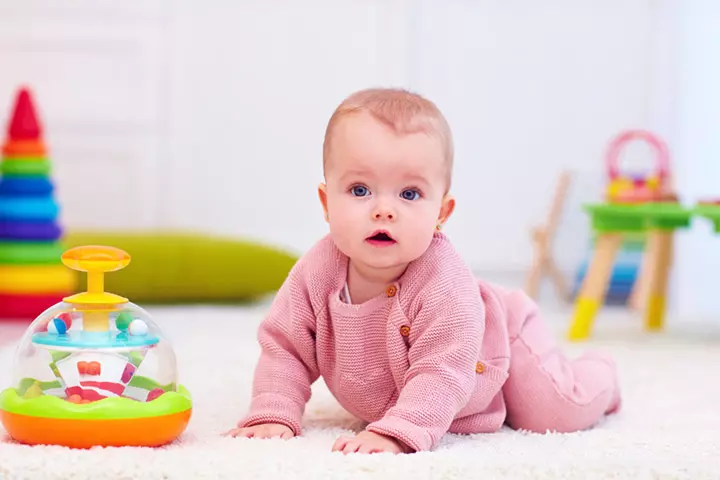
Dr. Barrios says, “Although fleas often bite the legs and arms, they also really like thin skin. Babies’ skin is extremely thin and vulnerable, which attracts these insects even more.”
- Make pets flea-free: To identify if your pet is suffering from flea bites, look for signs such as scratching, hair fall, redness, or scabs on the pet’s skin (15). Anti-flea sprays and flea collars can be used for pets to get rid of fleas. Bathing your pets regularly with anti-flea shampoos will help avoid flea infestation. Maintaining good hygiene is essential when you have pets at home. Combing your pets routinely also reduces the chances of fleas building up in their fur. Do not allow pets in the baby’s bed, as fleas can get into rugs and fur sheets. Take the help of a veterinary doctor to free your pet from fleas. Medical expert Dr. Po-Chang Hsu says, “Since pets are a common source of fleas, regular flea prevention is crucial. Make sure your pets are treated with veterinarian-approved flea medications, whether it is a topical treatment, oral medication, or a flea collar. Regularly bathing and grooming pets can help catch fleas early, reducing the risk of them spreading to your baby.”
- Go for pest control: Schedule a professional pest control program once a year or two in your home and surrounding area. You may have to shift to a different residence for a few days when pest control is going on, as it could cause an allergy.
- Clean the fabrics: Vacuum cleaning the doormats, rugs, carpets, fabric sofa covers, and other sheets is essential to get rid of any flea eggs or droppings. Treating such items with boric acid powder can help in preventing any insect build-up. Cleaning all suspected fabrics with warm steam is also an effective method (16).
- Use repellents: Insect repellent lotions can be applied over the body’s exposed areas when going out. According to the CDC, insect repellent fabric roll-ons and sprays can also be used to avoid any contact with fleas or other insects (8).
Frequently Asked Questions
1. Can a baby get sick from flea bites?
Flea bites mainly cause skin irritations for a short duration. However, they may sometimes spread diseases such as plague, cat scratch disease (CSD), or endemic murine typhusiFlea-borne bacterial disease causing flu-like symptoms . They may also be the carriers of parasites such as tapeworms (14).
2. Can fleas live in a baby bed?
Yes, fleas may survive in a baby’s bed. Fleas need warm environments to thrive. Baby beds could provide the ideal setting for their growth. Baby beds might also be infested with fleas if infected pets climb on them often.
3. Where do fleas hide in the house?
Fleas population could be the highest in warm places, often hidden from plain sight. Bed crevices, floor cracks, and furniture are the common flea harboring sites.
4. What can I spray on the bed to prevent fleas?
According to Dr. James Walker, assistant professor of Clinical Medicine at LSU Health Sciences Center New Orleans, “Several products can be used to spray on your bed for fleas. One effective option is a flea and tick spray specifically designed for use on bedding and furniture. You can also consider using a natural flea spray made from ingredients such as essential oils or vinegar. Be sure to carefully read the product label and follow the instructions for safe use.”
5. How can I tell flea bites from other insect bites?
Flea bites do not swell as big as bites from other insects, such as mosquitoes, and are generally not filled with fluid. Flea bites often are in a cluster or a straight line. Following a bite, the baby may develop a small, itchy bump with a discolored ring around it, distinguishing it from other insect bites (17).
Babies are more susceptible to flea bites due to their sensitive skin and the fact that they often play, lie, and crawl on the floor. While the bites usually subside on their own (16). The greater risk is the diseases flea may cause, such as typhus and plague. While flea bites do not need medical intervention, certain home remedies for soothing irritated skin may be helpful to calm your baby. In addition, pesticide treatment can help you eliminate fleas from your home. If your pets get flea, groom them well and get them treated.
Infographic: More On Flea Bites In Babies
Flea bites can be painful and quite uncomfortable for babies. And although the above information should help you deal with it, there are certain concerning symptoms of these bites and effective treatments that you must be aware of to ensure your baby gets the required help. This infographic will help understand these pointers.
Some thing wrong with infographic shortcode. please verify shortcode syntax
Illustration: Flea Bites On Babies: Pictures Treatment And Prevention

Image: Dalle E/MomJunction Design Team
Are store-bought bug repellents safe to use for babies? Watch this video to find out. Also, learn what precautions you should exercise when applying and some holistic alternatives to these repellents.
References
1. J. Anderson and E. Paterek; Flea Bites; The National Center for Biotechnology Information (2025)
2. J. C. Carlson and M. S. Fox; AA sticktight flea removed from the cheek of a two-year old boy from Los Angeles; Dermatology Online Journal (2009)
3. D. J. Yi Wong; Flea Bite; Dreamnet NZ (2014)
4. Fleas, Mites and Chiggers; Johns Hopkins Medicine
5. Fleas; MedlinePlus U. S. National Library of Medicine
6. Fleas; Centers for Disease Control and Prevention
7. M. R. Youssefi et al.; Dermatitis caused by Ctenocephalidesfelis (cat flea) in humans; Caspian Journal of Internal Medicine (2014)
8. About Murine Typhus; Centers for Disease Control and Prevention
9. Diseases from fleas; King County
10. Fleas; Environment Health and Quality; San Diego County
11. Prevalence of papularurticaria caused by flea bites and associated factors in children 1-6 years of age in Bagota, DC; World Allergy Organization Journal (2017)
12. Flea, Mite, or Chigger Bites in Children; Stanford Children’s Hospital
13. Flea Bites; American Osteopathic College of Dermatology
14. A. Burke; What Do Flea Bites Look Like on Dogs?; American Kennel Club
15. R. M. Houseman; Fleas, Extension University Of Missouri
16. Flea bites 101; Pest World.
17. Flea Bites; Cleveland Clinic.
18. Hey! A Flea Bit Me!; Nemours Children’s Health.
Community Experiences
Join the conversation and become a part of our nurturing community! Share your stories, experiences, and insights to connect with fellow parents.
Read full bio of Dr. Chetan Singh
- Dr. Raashid Hamid is a consultant in the department of Pediatric Surgery at GMC hospital and associate professor of Pediatric and Neonatal Surgery at SKIMS, Jammu & Kashmir, India. He has four years of experience and specializes in general surgeries, including appendectomy, cholecystectomy, and exploratory laparotomy.
 Dr. Raashid Hamid is a consultant in the department of Pediatric Surgery at GMC hospital and associate professor of Pediatric and Neonatal Surgery at SKIMS, Jammu & Kashmir, India. He has four years of experience and specializes in general surgeries, including appendectomy, cholecystectomy, and exploratory laparotomy.
Dr. Raashid Hamid is a consultant in the department of Pediatric Surgery at GMC hospital and associate professor of Pediatric and Neonatal Surgery at SKIMS, Jammu & Kashmir, India. He has four years of experience and specializes in general surgeries, including appendectomy, cholecystectomy, and exploratory laparotomy. - Dr. Maria Carmela Villania-Mamauag is a board certified diplomate of the Philippine Pediatric Society with a degree of Doctor of Medicine from Our Lady of Fatima University, Valenzuela City and a Bachelor in Science in Psychology from Saint Louis University, Baguio City which was augmented by a year of Bachelor in Science in Family Life and Child development at the University of the Philippines, Diliman, Quezon City.
 Dr. Maria Carmela Villania-Mamauag is a board certified diplomate of the Philippine Pediatric Society with a degree of Doctor of Medicine from Our Lady of Fatima University, Valenzuela City and a Bachelor in Science in Psychology from Saint Louis University, Baguio City which was augmented by a year of Bachelor in Science in Family Life and Child development at the University of the Philippines, Diliman, Quezon City.
Dr. Maria Carmela Villania-Mamauag is a board certified diplomate of the Philippine Pediatric Society with a degree of Doctor of Medicine from Our Lady of Fatima University, Valenzuela City and a Bachelor in Science in Psychology from Saint Louis University, Baguio City which was augmented by a year of Bachelor in Science in Family Life and Child development at the University of the Philippines, Diliman, Quezon City. - Dr. James Walker is a clinical doctor with over 10 years of experience managing patients. He currently works as an assistant professor of Clinical Medicine at LSU Health Sciences Center New Orleans. He did his MD from the University of Mississippi Medical Center.
 Dr. James Walker is a clinical doctor with over 10 years of experience managing patients. He currently works as an assistant professor of Clinical Medicine at LSU Health Sciences Center New Orleans. He did his MD from the University of Mississippi Medical Center.
Dr. James Walker is a clinical doctor with over 10 years of experience managing patients. He currently works as an assistant professor of Clinical Medicine at LSU Health Sciences Center New Orleans. He did his MD from the University of Mississippi Medical Center. 
Dr. Po-Chang Hsu is a medical doctor and medical content expert. He received his medical degree from Tufts University School of Medicine in Boston in 2016. Previously, he did a master’s degree at Harvard University and wrote a thesis on neuroimaging in schizophrenia patients at Brigham and Women’s Hospital. He currently works at Alpas Wellness.
Dr. Po-Chang Hsu is a medical doctor and medical content expert. He received his medical degree from Tufts University School of Medicine in Boston in 2016. Previously, he did a master’s degree at Harvard University and wrote a thesis on neuroimaging in schizophrenia patients at Brigham and Women’s Hospital. He currently works at Alpas Wellness.
Read full bio of Dr. Ritika Shah
Read full bio of Rohit Garoo
Read full bio of Shinta Liz Sunny






